

The Joyce Theater Foundation To Host the New York City Engagement from Japan's Sankai Juku
Two-week engagement of Japan's foremost exponent of contemporary Butoh dance Theater, October 24- November 5.
The Joyce Theater Foundation will host the New York City engagement of a rare North American tour from Japan's Sankai Juku. KŌSA – between two mirrorsh, the company's latest work, which mines the depths of nearly 50 years of Butoh repertoire from founder Ushio Amagatsu for fresh artistic insights, will play The Joyce Theater from October 24-November 5.
Japan's foremost exponent of contemporary Butoh dance theater, Sankai Juku returns to The Joyce with an evening-length compilation of reimagined excerpts from the company's vast repertoire. Entitled KŌSAe, the work exemplifies the elegance, refinement, and emotional depth that are not only hallmarks of the art form, but also the artistic calling cards of Sankai Juku and its founder and choreographer, Ushio Amagatsu. With no decor—only pure dance spectacle and technical precision—dancers bring audiences into Amagatsu's spellbinding and philosophical world, revisiting oft-performed pieces with the fresh curiosity of a first-time artistic exploration. Simultaneously thought-provoking and an homage to the rich legacy of Japanese dance theater, KŌSA offers devoted fans of Sankai Juku a unique retrospective and a comprehensive introduction to Butoh for new audiences.
The 2023 North American tour of Sankai Juku is supported by the Agency for Cultural Affairs, Government of Japan through the Japan Arts Council.
Sankai Juku is a Butoh dance company founded by Ushio Amagatsu in 1975. The company has premiered a new piece approximately once every two years at Théâtre de la Ville, Paris, a center for contemporary dance. Sankai Juku is one of the few dance companies that Théâtre de la Ville, Paris has commissioned continuously for 35 years. Ushio Amagatsu, Artistic Director, trained in both classical and modern dance before he became immersed in Butoh. For Amagatsu, Butoh expresses the language of the body. In the 1970s, Amagatsu drew mostly on his own individual experience for inspiration. During the 1980s he spent most of his time working in Europe and the inspiration for his work became more universal. In his works, Amagatsu presents an abstract vision of the infinite and explores evolutionary movement. Major themes that he examines are the relationship of the body to gravity and the relationship between gravity, the earth and the environment. In 1980, Sankai Juku was invited to perform in Europe for the first time. The company went to the Nancy International Festival in France with the firm conviction that Butoh would be accepted. This engagement marked a major turning point and made a name for both Sankai Juku and the term Butoh throughout Europe. Sankai Juku received the Japan Foundation Award in 2013. The company has toured internationally since 1980 and performed in over 700 cities in 45 countries throughout Europe, Asia, Oceania and the Americas. They have been highly praised in different cultures for over 35 years which is a testament to the universal nature of Sankai Juku's work. While crossing over geographic borders and appealing to diverse audiences, the company has been developing the themes of their work while searching for and moving towards new realms.
The Joyce Theater Foundation (“The Joyce,” Executive Director, Linda Shelton), a non-profit organization, has proudly served the dance community for more than four decades. Under the direction of founders Cora Cahan and Eliot Feld , Ballet Tech Foundation acquired and renovated the Elgin Theater in Chelsea. Opening as The Joyce Theater in 1982, it was named in honor of Joyce Mertz, beloved daughter of LuEsther T. Mertz. It was LuEsther's clear, undaunted vision and abundant generosity that made it imaginable and ultimately possible to build the theater. Ownership was secured by The Joyce in 2015. The theater is one of the only theaters built by dancers for dance and has provided an intimate and elegant home for over 475 U.S.-based and international companies. The Joyce has also expanded its reach beyond its Chelsea home through off-site presentations at venues ranging in scope from Lincoln Center's David H. Koch Theater, to Brooklyn's Invisible Dog Art Center, and outdoor programming in spaces such as Hudson River Park. To further support the creation of new work, The Joyce maintains longstanding commissioning and residency programs. Local students and teachers (1st–12th grade) benefit from its school program, and family and adult audiences get closer to dance with access to artists. The Joyce's annual season of about 48 weeks of dance includes over 300 performances for audiences of over 100,000.
The Joyce Theater presents the return of Sankai Juku in KŌSAJ from October 24-November 5. The performance schedule is as follows: Tue-Wed 7:30pm; Thu-Fri 8pm; Sat 2pm & 8pm; Sun 2pm. Tickets, ranging in price from $12-$72 (including fees), can be purchased at www.Joyce.org , or by calling JoyceCharge at 212-242-0800. Please note: ticket prices are subject to change. For more information, please visit www.Joyce.org .
The Joyce Theater is located at 175 Eighth Avenue at West 19th Street.
Play Broadway Games
TICKET CENTRAL

Recommended For You


- Entertainment
- Rex Reed Reviews
- Awards Shows
- Climate Change
- Restaurants
- Gift Guides
- Business of Art
- Nightlife & Dining
- About Observer
- Advertise With Us
Between Mountain and Sea: Butoh Comes to the Joyce
It’s been said that the butoh dancer is in a state of “hyper-presence,” aware of everything inside and outside of their body..
Japan’s foremost contemporary Butoh dance company, Sankai Juku , is making a rare U.S. tour and stopping at The Joyce Theater through November 5. They will perform KŌSA – between two mirrors , an evening-length work compiling excerpts from the company’s nearly 50-year repertoire. For Butoh enthusiasts, KŌSA is a once-in-a-blue-moon chance to see a retrospective of masterpieces danced by master performers. For those new to Butoh, it’s a perfect introduction to the Japanese dance form.
Sign Up For Our Daily Newsletter
Thank you for signing up!
By clicking submit, you agree to our <a rel="nofollow noreferer" href="http://observermedia.com/terms">terms of service</a> and acknowledge we may use your information to send you emails, product samples, and promotions on this website and other properties. You can opt out anytime.

The Tokyo-based Sankai Juku was founded in 1975 by Ushio Amagatsu , who still serves as their Artistic Director, Choreographer and Designer. Amagatsu was born in Yokosuka, Japan in 1949, and trained in both classical and modern dance before finding his home in the Butoh style, which he feels expresses the language of the body most honestly. “Butoh is a dialogue with gravity,” he has said . Not an escape from it, like most other dance forms. In many ways, Butoh is a dialogue with, not an escape from, everything , especially those things we fear and try to avoid. It’s an act of whole-body staring into the metaphysical void.
SEE ALSO: The Newly Reopened NMWA Offers a Museum-Going Experience Powered by Advocacy
To understand Amagatsu’s work, it helps to know a bit about Butoh. Butoh (roughly translated as “dance step”) originated as a revolutionary performance art in Japan in the late 1950s and early 1960s. Created in the shadow of WWII and the atomic bombings, it was a rejection of all things Western: Western dance styles (except for German Expressionist dance), Western concerns and capitalism. It was also a rejection of Japanese classical dance which focuses on grace and order, aesthetics that no longer made cultural sense. Tatsumi Hijikata and Kazuo Ohno, both trained dancers and credited as the two founders of Butoh, wanted to carve out a space for the grotesque, the perverse, and the disturbing. In other words: everyday life in post-war Japan. Butoh is actually short for Ankoku Butoh (Dance of Darkness), the style’s original name.
Over the years, Butoh has grown lighter, thanks in large part to Amagatsu. When he started choreographing in the mid-1970s, after training with Hijikata, he maintained much of the style’s traditional aspects: the white body makeup (to draw focus away from the individual and toward the movement), the shaved heads (inspired by German dancer and choreographer Herald Kreutzberg), the hyper-controlled slow motion. But his themes were different. Instead of focusing on the devastations of war, death, and disease, he became interested in gravity, evolutionary movement, and transcendence.
Amagatsu’s Sankai Juku helped revolutionize Butoh, leading the style’s second generation and paving the way for its third. They have created more than 16 works and toured internationally since 1980, introducing new audiences to Butoh and winning countless accolades along the way.
KŌSA can be seen as a performance of the evolution of Butoh.

Sankai Juku means “studio between mountain and sea,” and that image is present throughout the 90-minute piece. It is present in Genta Iwamura’s watery lighting and Masayo Iizuka’s simple, earthen costumes. It is present in the small piles of sand on the stage and the dancers’ grounded, fluid movements
The coastline has long symbolized the thin line between life and death, a space that Butoh—even contemporary Butoh—philosophically inhabits. While the works of the 1960s waded into the dark water, Amagatsu’s work is decidedly alive.
It’s been said that the Butoh dancer is in a state of “hyper-presence,” aware of everything inside and outside of their body. I wasn’t quite sure what this meant until Sho Takeuchi lifted his arm to begin the performance. To watch him dance is to see a human transformed into other. It is, to be frank, a near-holy experience. His presence filled the entire theater, and no one could take their eyes from his finger slowly pointing up then down, his torso bending to the side like seagrass.
It has also been said that a Butoh dancer “should not dance, but be danced.” The idea is that the dance already exists inside the performer and must emerge from within. This is easier said than done, but Takeuchi and the rest of the all-male cast (Akihito Ichihara, Norihito Ishii, Sōtaro Ito, Taiki Iwamoto, Dai Matsuoka, and Makoto Takese) do it.

KŌSA is a meditation, but not a relaxing one. It takes on “the anxieties acutely felt by many in the past few years” in a raw, wordless way. Mouths occasionally contort into silent screams, and hands bend into blunt claws. They wipe at the air above their heads in a meaningless ceremonial way. In one unforgettable moment, four dancers paint red wounds on each other’s faces with quick swipes of their fingers. They laugh slowly, ghoulishly, pointing. Then, with horror film timing, they turn to the audience and look right through us. They point and laugh, and the fourth wall isn’t just broken, its very existence is publicly shamed. And then they are dancing again, those beings who were terrifying a moment ago and are now floating across the stage with flower petal delicacy.
The music, by YAS-KAZ and Yoichiro Yoshikawa, is a mash-up of classical Japanese and contemporary music. There is traditional drumming and flute, but also electric guitar and something that sounds like a close-up helicopter. It, too, is at once ancient and avant-garde, though less appealing than the movement.
Near the end, the back curtains part and a bright soapy green scrim wakes us up. As more dancers join the stage, the colors soften to seashell pink and blue and we’re back there, all of us, at the shore.

- SEE ALSO : Leonora Carrington’s Surrealist Masterpiece Expected to Sell for a Record $18M
We noticed you're using an ad blocker.
We get it: you like to have control of your own internet experience. But advertising revenue helps support our journalism. To read our full stories, please turn off your ad blocker. We'd really appreciate it.
How Do I Whitelist Observer?
Below are steps you can take in order to whitelist Observer.com on your browser:
For Adblock:
Click the AdBlock button on your browser and select Don't run on pages on this domain .
For Adblock Plus on Google Chrome:
Click the AdBlock Plus button on your browser and select Enabled on this site.
For Adblock Plus on Firefox:
Click the AdBlock Plus button on your browser and select Disable on Observer.com.

sankai_juku_hero.jpg
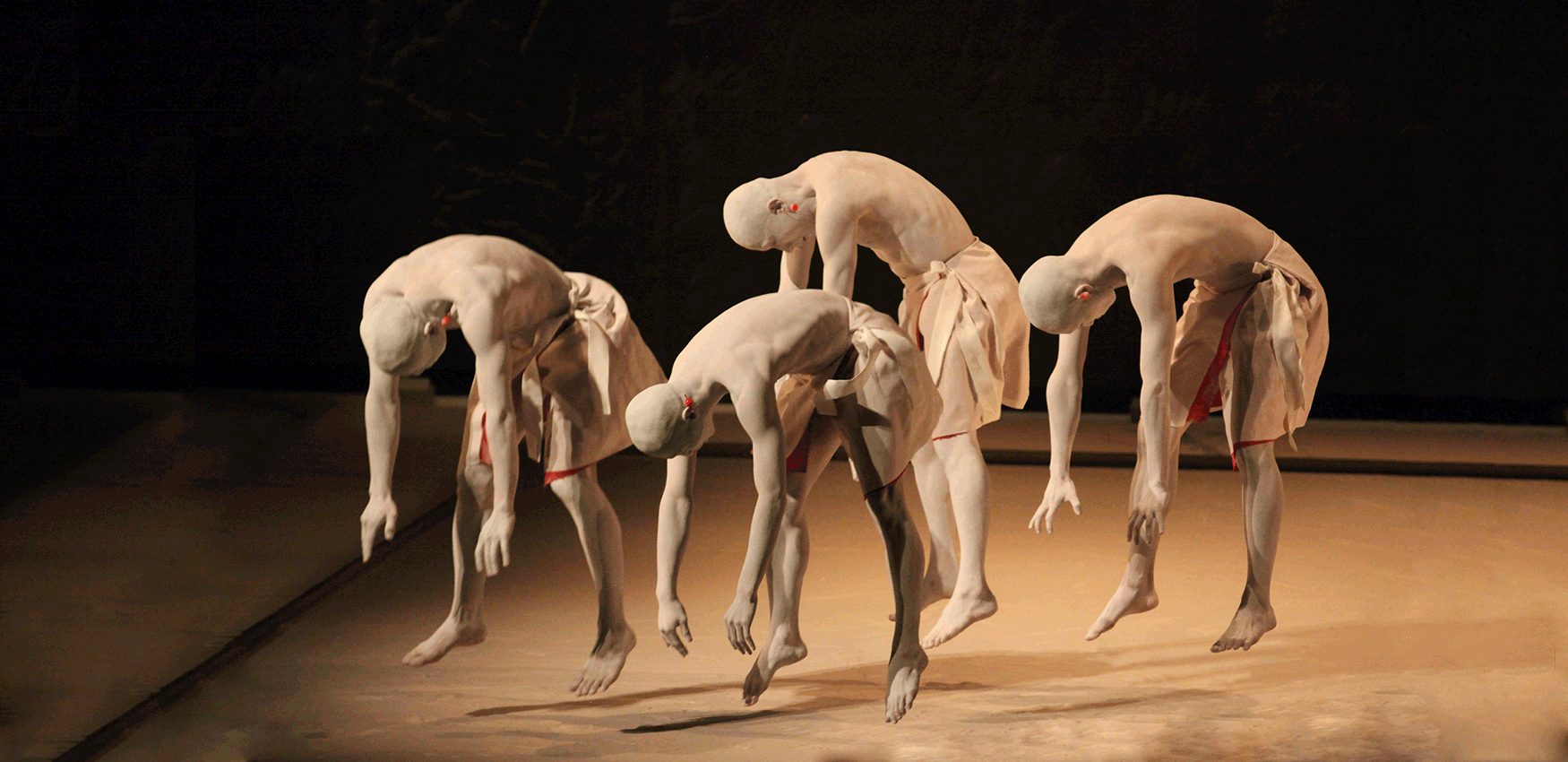
You are here
- Events & Tickets
Sankai Juku
Meguri: Teeming Sea, Tranquil Land
Performance Dates
- Thu Oct 17 2019 8:00 PM
- Fri Oct 18 2019 8:00 PM
- Sat Oct 19 2019 8:00 PM
- [email protected]
- (206) 543-4880
- Get Directions
- Share on Facebook
Declared “one of the most original and startling dance theater groups to be seen” by The New York Times, Sankai Juku is renowned as Japan’s finest example of contemporary Butoh. Directed, choregraphed and designed by Ushio Amagatsu, Sankai Juku's exquisite new work, Meguri: Teeming Sea, Tranquil Land is a poetic meditation on the passage of time as symbolized by the circulation of water and the seasonal transformation of the earth. Amagatsu’s works are sublime visual spectacles and deeply moving theatrical experiences.
The singular glory of Sankai Juku is that it achieves almost pure metaphor. — Time
(NOTE: there will be no pre- or post-show lecture for this event.)
The ENCORE program for this performance is available to READ ONLINE
World Dance Series generously underwritten by the families of Delaney and Justin Dechant and Ira and Courtney Gerlich in honor of their Mom, Katharyn Alvord Gerlich
Directed, Choreographed, and Designed by: USHIO AMAGATSU
Music by: Takashi Kako, YAS-KAZ, Yochiro Yoshikawa
Dancers: Semimaru Toru Iwashita Sho Takeuchi Akihito Ichihara Dai Matsuoka Norihito Ishii Shunsuke Momoki Taiki Iwamoto
Realization of Sea Lilies (décor): Roshi
Costume Realization: Masayo Iizuka
Co-produced by: Theatre de la Ville (Paris, France) Esplanade – Theatre on the Bay (Singapore) Kitakyushu Performing Arts Center, (Fukuoka, Japan) Sankai Juku, (Tokyo, Japan)
North American Tour Produced by: Pomegranate Arts Linda Brumbach, Executive Producer Alisa E. Regas, Associate Producer
World Premiere: Kitakyushu Performing Arts Center, March 2015
Sankai Juku’s 2019 North American tour is supported by Shiseido
sankai_juku_official_movie_meguri_shan_hai_shu_-_butoh_dance_wu_ta_-
ushio_amagatsu_sankai_juku_jp_meguri_-_teeming_sea_tranquil_land

meguri_c_sankai_juku_12.jpg
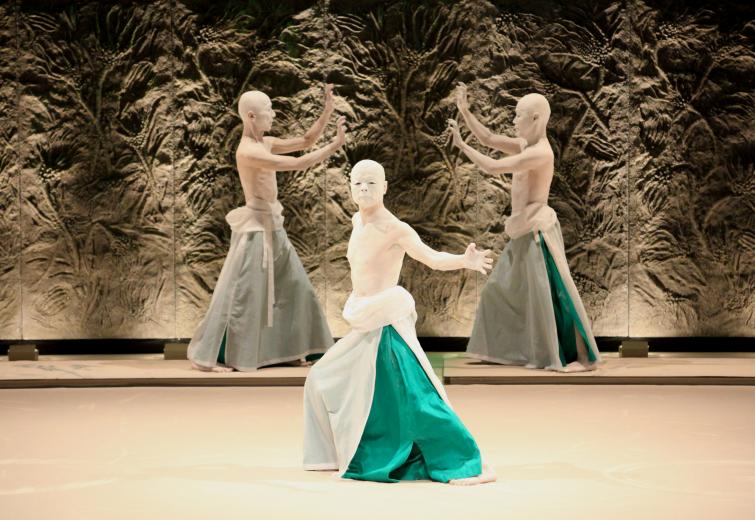
meguri_c_sankai_juku_14.jpg
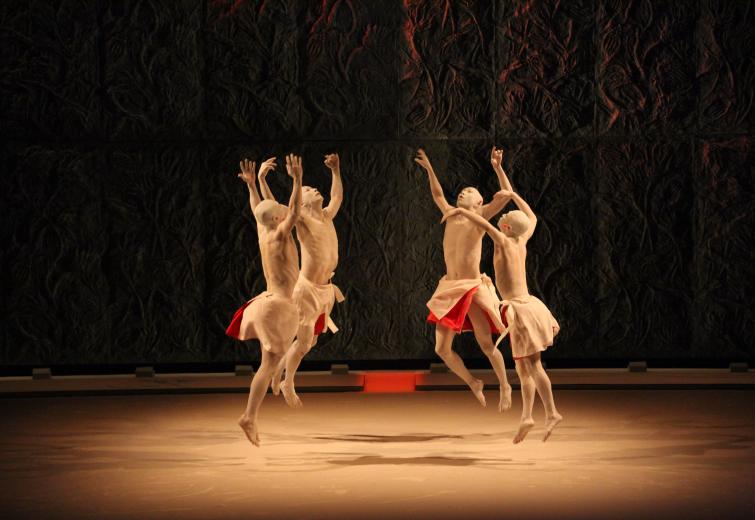
meguri_c_sankai_juku_10.jpg
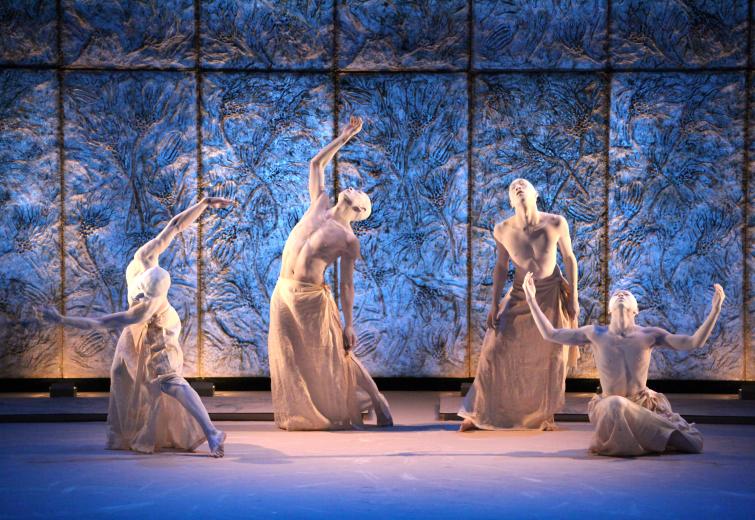
About the Artist
A history of butoh, inspired by images in the mind's eye, psyche-penetrating butoh artistry — plus lots of sand.
- Entertainment
Sankai Juku to bring ‘Umusuna’ to UW
Every production of this world-renowned butoh troupe contains mesmerizing images of extraordinary beauty in which the physical body is transformed into an element of the spiritual world.
Share story
There are few performing companies in the world that tap the unconscious more deeply than Sankai Juku. Every production of this world-renowned butoh troupe contains mesmerizing images of extraordinary beauty in which the physical body is transformed into an element of the spiritual world.
Through highly ritualistic movements and dazzling theatrical effects, Sankai Juku lures the audience into an almost trancelike state that often requires hours, days or even weeks to fully absorb. When that happens Sankai Juku’s genius becomes even more striking.
All Sankai Juku productions explore universal themes, as Seattle audiences are well aware given the company’s frequent appearances here. “ Umusuna — Memories Before History ,” which begins its North American tour in Seattle after premiering in France in 2012, is no different. The title of the work means “place of one’s birth” in Japanese, and artistic director-choreographer Ushio Amagatsu says he created the piece “to express the places where humans have a connection with nature and the elements of earth, water, fire and air.”
Dance preview
Sankai juku.
8 p.m. Oct. 1-3, UW World Series, Meany Hall, University of Washington; $50-$55 ( uwworldseries.org or 206-543-4880).
Amagatsu expresses those four elements through different colored stage lights that change as one scene flows seamlessly into the next; the colors of each section are reflected in the costumes as well. What’s constant is a stream of sand that falls continuously throughout the performance. According to Amagatsu, the stream is designed to show life as a vertical line, something that never disappears.
Most Read Entertainment Stories
- K-pop star Jay of ENHYPEN talks about WA roots, Fate Plus world tour
- HGTV's 'Ugliest House in America' has some thoughts on WA homes
- 'The Bachelorette: Season 21,' featuring Jenn Tran, films in Seattle WATCH
- Photographer alleges he was forced to watch Megan Thee Stallion have sex and was unfairly fired
- Long-lost Klimt painting sells for $37 million at auction
The physical appearance of the performers enhances the sense that we are participating in a universal human experience. As in all Sankai Juku productions, the seven male dancers, including Amagatsu himself, are baldheaded and bare-chested. They wear skirts and dangling earrings, to blur gender differences, but their most striking aspect is the white paint that covers their bodies.
“I see [the paint] as a tool to erase individuality,” Amagatsu explains. “[It] helps remove bodily features, emphasizing the fact that the dancers are merely human beings.”
White paint has always been an integral part of butoh , which developed in Japan in the post-World War II period. Founded as a reaction to the human suffering and imposition of Western culture that resulted from Japan’s defeat, the first generation of butoh artists created visual images that were often violent and grotesque.
Butoh’s second generation, among whom Amagatsu and Sankai Juku are the most celebrated, focus on more universal and timeless themes such as birth, death, regeneration and redemption. Amagatsu rarely deals with these themes explicitly; rather he creates a mood or feeling that inspires viewers to find their own meanings in his stunning tableaux. Indeed, one of the great pleasures of any Sankai Juku performance is comparing responses with those of other viewers who sometimes draw completely different import from Amagatsu’s powerful abstract images.
Part of what gives Sankai Juku its consistency from one production to another is the fact that almost all the dancers have been with the troupe for at least 10 years. Although Amagatsu is the sole choreographer, he has developed a unique way of involving the dancers in his creative process. It’s an organic method that includes rehearsing without music or mirrors and requires the dancers to focus internally more than externally.
“On our first day together, I start with a short lecture on what I want to do in the new piece,” he explains, “and once I have communicated that, we begin working on the actual physical movements. I ask the dancers to try not to cut the flow of consciousness when they dance so we concentrate more on that than the outside forms.”
Amagatsu works with his composers in an equally collaborative way. If the music already exists, he may ask for sections to be rearranged or specific instruments to be changed; if the score is original, he’ll make suggestions for which instruments to use or what qualities of sound he’s looking for. In either case, he’s always in the studio when the recording is being made. “At the studio, I feel the vibrations of the live sound with my body and think about to what degree it can be used in the stage performance.”
Amagatsu once said that the power in Sankai Juku’s performances comes from the beauty of its visions. As those who have seen Sankai Juku can attest, it’s not unusual for those visions to leave a permanent mark on both the conscious and unconscious mind.
Sankai Juku UMUSUNA from Pomegranate Arts on Vimeo .
Note: This article was corrected on Monday, Sept. 28, 2015. An earlier version carried an incorrect ticket price .
SANKAI JUKU
city / country
Biwako hall center for the performing arts
KAGEMI recreation
Biwako hall
Yanagawa / JPN
Yanagawa Civic Cultural Center Suito Yanagawa
Toyooka / JPN
Toyooka Citizen's Hall
Toyooka Theater Festival
Fribourg/Swiss
KŌSA –
between two mirrors
Equilibre, Fribourg
Thonon-les-Bains /FRANCE
Maison des Arts du Léman
Aix-en-Provence /FRANCE
Le Pavillon Noir
Guanajuato /MEXICO
Auditorio del Centro de Convenciones de Guanajuato
Festival International Cervantino
MexicoCity /MEXICO
Mexiko-Stadt, Hauptstadtdistrikt, MEXICO
Palacio de Bellas Artes
Bogota / COLOMBIA
Teatro Mayor
Medellin / COLOMBIA
Teatro Mertopolitano
São Paulo/BRASIL
Teatro Alfa
Sankai Juku “MEGURI—Teeming Sea, Tranquil Land”(re-creation)

A magnificent lyric conveys the memories of our land and oceans accumulated over hundreds of millions of years
Sankai Juku is a Butoh company based in France and Japan. The company’s works, which are known for their sophisticated physical expression and formative beauty, have been appreciated in forty-eight countries around the world. Sankai Juku’s director and choreographer, Ushio Amagatsu, regarded his Butoh as a “dialogue with gravity,” and his works that touch on universal aspects of human nature, such as birth and death, are highly acclaimed worldwide.
“MEGURI—Teeming Sea, Tranquil Land” was premiered in Kitakyushu Performing Arts Center in 2015 and has been performed in various places, including Tokyo, France, and Singapore. In a form of recreation, MEGURI now returns to Kitakyushu for the first time since its premier nine years ago.
A wall covered with crinoid fossils stands firmly as water basins quietly move up and down. From ancient times to the present, a magnificent lyric conveys the memories of the earth and oceans that have accumulated through hundreds of millions of years, capturing the small lives that have appeared and disappeared through time. Please enjoy the world of Sankai Juku, which has gained a solid reputation in Japan and around the world.
Link to the Project page
Director, Choreographer, and Designer
Ushio Amagatsu
Takashi Kako, YAS-KAZ, Yoichiro Yoshikawa

Assistant Director
Semimaru, Sho Takeuchi, Akihito Ichihara, Dai Matsuoka, Norihito Ishii, Taiki Iwamoto, Makoto Takase, Sotaro Ito
J:COM Kitakyushu Performing Arts Center Tel 093-562-2655(10:00-18:00) Email [email protected] *Telephone assistance is in Japanese only
Information
Organized by Kitakyushu City Foundation for Promoting Arts and Culture Co-organized by Kitakyushu City
Dates/Venue
Chugekijo Theatre May 12 (Sun) 14:00 ※Doors open 30 minutes before the performance.
Reserved seating only, Tax included Adult: 4,500 yen Youth: 2,500 yen (under 25 years old with valid ID) Teen: 1,500 yen (13~19 years old with valid ID; limited number at theater ticket office) ※Children must be above preschool age.
Ticket sale date
Sunday, March 24, 2024 10:00
Advanced ticket sales for the members
KICPAC members Saturday, March 16, 2024 10:00-17:00 Online ticket (10:00-17:00) Ticket Club Q members Saturday, March 23, 2024 10:00-17:00 Online ticket (10:00-17:00)
Ticket sale
Kitakyushu Performing Arts Center Ticket office Online ticket TEL 093-562-8435 (12:00-17:00/weekdays only) HIBIKI Hall Office *Telephone assistance is in Japanese only
Other services
Ticket Pia Lawson Ticket
1-1-1-11 Muromachi, Kokurakita-ku, Kitakyushu 803-0812 See here for more details
Childcare and other services
Please see our list of services .
以下のキーワード検索、またはサイトマップよりページを検索できます。
北九州芸術劇場 ウェブサイト
- 施設ご案内資料・申請書類
- 現在進行中のプロジェクト
- 当サイトのご利用について /プライバシーポリシー
- Share full article
Advertisement
Supported by
SANKAI JUKU ENDS TOUR
By Leslie Bennetts
- Sept. 12, 1985
The Japanese avant-garde dance troupe Sankai Juku has canceled the rest of its 10-city United States tour following the death of one of its dancers during the company's opening performance in Seattle on Tuesday.
The dancer, Yoshiuki Takada, plunged six stories to his death when a rope snapped during an outdoor performance being staged on the facade of Seattle's Mutual Life Building in front of a crowd estimated at 2,000 people. The dance, which the company has performed more than a hundred times in cities around the world, was an excerpt from a large outdoor event entitled ''Sholiba.'' The piece features four dancers hanging upside down from the top of a building and being lowered slowly to the ground while a fifth performer stands on the roof blowing a conch shell. A similar performance was given by Sankai Juku in New York last year at the City Center.
A spokesman for the company said that only one rope of the four used in the performance had been tested beforehand, and that it was one of the three untested ropes that broke. ''They do not carry their own rope, because building heights vary and so forth,'' explained Jedediah Wheeler, co-director of International Production Associates, the American agents for Sankai Juku. ''They ask the local promoter to provide three-quarter inch used hemp, and the key element is that it be used, because new line twirls and spins. What that would do on the descent is that the body would spin, which is not the effect they're looking for. This is a slow 30-minute descent, and there's a lot of stillness involved.''
Four Minutes Into the Piece
The dancers were only about four minutes into the piece when Mr. Takada, who was 31 years old and had been with the company for 10 years, fell to the ground. ''There wasn't panic or confusion at all,'' said Mr. Wheeler, who spoke in a telephone interview from Seattle. ''There was utter silence and then an overwhelming rush of tears and people hugging each other and comforting each other that went on for at least an hour afterward. The outpouring of emotions is very strong here. There was a candlelight vigil at the death site by members of the Seattle community, and people are leaving flowers, wreaths and poems.''
Mr. Takada, who was given cardio-pulmonary resuscitation at the scene, was later pronounced dead at the Harborview Medical Center.
Mr. Wheeler said that members of the company were ''in utter shock,'' but that they had vowed to continue performing in the future.
He added that the piece being performed when the accident occurred, like the company's other work, involves a motif of birth and death. ''The ritual of the life cycle, of birth through death, is a recurring theme of all their pieces,'' Mr. Wheeler said.
Stepping Into the World of Dance
As Harlem Stage’s E-Moves dance series turns 25, Bill T. Jones and other major choreographers discuss its impact on Black dance in New York.
“We the People,” Jamar Roberts’s first dance for the Martha Graham Dance Company, finds the rage and resistance hidden in an upbeat score by Rhiannon Giddens.
In “Nail Biter,” a New York City premiere, the exacting choreographer Beth Gill explores her ballet roots and how to be in her body now.
The choreographer Emma Portner, who has spent her career mixing genres and disciplines , comes to ballet with an eye on its sometimes calcified gender relations.
A childhood encounter with an American soldier in Iraq led Hussein Smko to become a dancer. Now the artist performs on New York stages .
“Deep River” is in many ways an apt title for a dance work by Alonzo King, a choreographer fixated on flow .
- AT&T PAC
Due to inclement weather, Forgotten Space in Strauss Square on 4/27 has been rescheduled. All other events are proceeding as scheduled. Read more >
TITAS/DANCE UNBOUND Presents
Sankai Juku (Japan)
Known worldwide for its elegance, precision, and emotional depth
“The singular glory of Sankai Juku is that it achieves almost pure metaphor” TIME
Tokyo’s Sankai Juku is known worldwide for its elegance, precision, and emotional depth. Founder Ushio Amagatsu is one of the premiere choreographers in the world today. These rare works are to be experienced more than watched.
With KŌSA , Amagatsu has built this new evening-length work in an effort to present the most essential elements of his vision. Sankai Juku is simply very, very special. It is a stunning immersive experience, rich with Japanese culture, artistic excellence and the power of creativity. After decades of absence from Dallas, we welcome this stunning company back to Texas.
You may also like
Dance socials.
Apr 3 - May 22, 2024
No partner or experience required. Come have fun, sip on refreshing cocktails and learn new moves to impress on the dance floor!
Beauty and the Beast Dallas
May 3 - 5, 2024
Love conquers all in this beautiful ballet.
Tres Artes: Pintura, Poesia, y Pasion
May 11, 2024
In a show that combines four dynamic art forms - live music, dancing, visual art, and poetry - prepare for something unforgettable.
Spring Celebration
May 17 - 18, 2024
As our 47th season draws to a close, we invite you to join us for our grand finale!
Ghosts: Do You Believe?
May 20, 2024
Brace yourself for an interactive journey through haunted encounters, mind boggling phenomena, and first-hand accounts that will leave you questioning everything you thought you knew.
Academy Spring Recital
May 25, 2024
Celebrate Dallas Black Dance Theatre's 50th anniversary with a special edition of their annual recital.
TL Collective
May 31 - Jun 1, 2024
Suave Gonzalez - Never Give Up Tour
Jun 6, 2024
Artist, speaker, and the first formerly incarcerated person in the United States to ever win a Pulitzer Prize Award and IDA International Documentary Award for his podcast "SUAVE." Live on stage featuring: Suave Gonzalez, Rasheeda Hyland & Joey Deville.
Jun 7 - 9, 2024
Experience the grand finale of Bruce Wood’s 14th season with RADIANCE, an unforgettable showcase featuring three captivating and emotionally powerful dance performances.
Museum and Exhibition Center

Most Recent: Reviews ordered by most recent publish date in descending order.
Detailed Reviews: Reviews ordered by recency and descriptiveness of user-identified themes such as wait time, length of visit, general tips, and location information.

Museum and Exhibition Center - All You Need to Know BEFORE You Go (2024)
- (0.03 mi) Elektrostal Hotel
- (1.15 mi) Yakor Hotel
- (1.42 mi) Mini Hotel Banifatsiy
- (1.65 mi) Apelsin Hotel
- (1.33 mi) Elemash
- (0.20 mi) Prima Bolshogo
- (0.30 mi) Makecoffee
- (0.40 mi) Mazhor
- (0.42 mi) Amsterdam Moments
- (0.42 mi) Pechka
Claudia Looi
Touring the Top 10 Moscow Metro Stations
By Claudia Looi 2 Comments

Komsomolskaya metro station looks like a museum. It has vaulted ceilings and baroque decor.
Hidden underground, in the heart of Moscow, are historical and architectural treasures of Russia. These are Soviet-era creations – the metro stations of Moscow.
Our guide Maria introduced these elaborate metro stations as “the palaces for the people.” Built between 1937 and 1955, each station holds its own history and stories. Stalin had the idea of building beautiful underground spaces that the masses could enjoy. They would look like museums, art centers, concert halls, palaces and churches. Each would have a different theme. None would be alike.
The two-hour private tour was with a former Intourist tour guide named Maria. Maria lived in Moscow all her life and through the communist era of 60s to 90s. She has been a tour guide for more than 30 years. Being in her 60s, she moved rather quickly for her age. We traveled and crammed with Maria and other Muscovites on the metro to visit 10 different metro stations.

Arrow showing the direction of metro line 1 and 2

Moscow subways are very clean
To Maria, every street, metro and building told a story. I couldn’t keep up with her stories. I don’t remember most of what she said because I was just thrilled being in Moscow. Added to that, she spilled out so many Russian words and names, which to one who can’t read Cyrillic, sounded so foreign and could be easily forgotten.
The metro tour was the first part of our all day tour of Moscow with Maria. Here are the stations we visited:
1. Komsomolskaya Metro Station is the most beautiful of them all. Painted yellow and decorated with chandeliers, gold leaves and semi precious stones, the station looks like a stately museum. And possibly decorated like a palace. I saw Komsomolskaya first, before the rest of the stations upon arrival in Moscow by train from St. Petersburg.
2. Revolution Square Metro Station (Ploshchad Revolyutsii) has marble arches and 72 bronze sculptures designed by Alexey Dushkin. The marble arches are flanked by the bronze sculptures. If you look closely you will see passersby touching the bronze dog's nose. Legend has it that good luck comes to those who touch the dog's nose.

Touch the dog's nose for good luck. At the Revolution Square station

Revolution Square Metro Station
3. Arbatskaya Metro Station served as a shelter during the Soviet-era. It is one of the largest and the deepest metro stations in Moscow.

Arbatskaya Metro Station
4. Biblioteka Imeni Lenina Metro Station was built in 1935 and named after the Russian State Library. It is located near the library and has a big mosaic portrait of Lenin and yellow ceramic tiles on the track walls.

Lenin's portrait at the Biblioteka Imeni Lenina Metro Station

5. Kievskaya Metro Station was one of the first to be completed in Moscow. Named after the capital city of Ukraine by Kiev-born, Nikita Khruschev, Stalin's successor.

Kievskaya Metro Station
6. Novoslobodskaya Metro Station was built in 1952. It has 32 stained glass murals with brass borders.

Novoslobodskaya metro station
7. Kurskaya Metro Station was one of the first few to be built in Moscow in 1938. It has ceiling panels and artwork showing Soviet leadership, Soviet lifestyle and political power. It has a dome with patriotic slogans decorated with red stars representing the Soviet's World War II Hall of Fame. Kurskaya Metro Station is a must-visit station in Moscow.

Ceiling panel and artworks at Kurskaya Metro Station

8. Mayakovskaya Metro Station built in 1938. It was named after Russian poet Vladmir Mayakovsky. This is one of the most beautiful metro stations in the world with 34 mosaics painted by Alexander Deyneka.

Mayakovskaya station

One of the over 30 ceiling mosaics in Mayakovskaya metro station
9. Belorusskaya Metro Station is named after the people of Belarus. In the picture below, there are statues of 3 members of the Partisan Resistance in Belarus during World War II. The statues were sculpted by Sergei Orlov, S. Rabinovich and I. Slonim.

10. Teatralnaya Metro Station (Theatre Metro Station) is located near the Bolshoi Theatre.

Teatralnaya Metro Station decorated with porcelain figures .

Taking the metro's escalator at the end of the tour with Maria the tour guide.
Have you visited the Moscow Metro? Leave your comment below.
January 15, 2017 at 8:17 am
An excellent read! Thanks for much for sharing the Russian metro system with us. We're heading to Moscow in April and exploring the metro stations were on our list and after reading your post, I'm even more excited to go visit them. Thanks again 🙂
December 6, 2017 at 10:45 pm
Hi, do you remember which tour company you contacted for this tour?
Leave a Reply Cancel reply
You must be logged in to post a comment.
Please go to the Instagram Feed settings page to create a feed.

For the first time Rosatom Fuel Division supplied fresh nuclear fuel to the world’s only floating nuclear cogeneration plant in the Arctic
The fuel was supplied to the northernmost town of Russia along the Northern Sea Route.

The first in the history of the power plant refueling, that is, the replacement of spent nuclear fuel with fresh one, is planned to begin before 2024. The manufacturer of nuclear fuel for all Russian nuclear icebreakers, as well as the Akademik Lomonosov FNPP, is Machinery Manufacturing Plant, Joint-Stock Company (MSZ JSC), a company of Rosatom Fuel Company TVEL that is based in Elektrostal, Moscow Region.
The FNPP includes two KLT-40S reactors of the icebreaking type. Unlike convenient ground-based large reactors (that require partial replacement of fuel rods once every 12-18 months), in the case of these reactors, the refueling takes place once every few years and includes unloading of the entire reactor core and loading of fresh fuel into the reactor.
The cores of KLT-40 reactors of the Akademik Lomonosov floating power unit have a number of advantages compared to the reference ones: a cassette core was used for the first time in the history of the unit, which made it possible to increase the fuel energy resource to 3-3.5 years between refuelings, and also reduce the fuel component of the electricity cost by one and a half times. The FNPP operating experience formed the basis for the designs of reactors for nuclear icebreakers of the newest series 22220. Three such icebreakers have been launched by now.
For the first time the power units of the Akademik Lomonosov floating nuclear power plant were connected to the grid in December 2019, and put into commercial operation in May 2020. The supply of nuclear fuel from Elektrostal to Pevek and its loading into the second reactor is planned for 2024. The total power of the Akademik Lomonosov FNPP, supplied to the coastal grid of Pevek without thermal energy consumption on shore, is about 76 MW, being about 44 MW in the maximum thermal power supply mode. The FNPP generated 194 million kWh according to the results of 2023. The population of Pevek is just a little more than 4 thousand, while the FNPP has a potential for supplying electricity to a city with a population of up to 100 thousand people. After the FNPP commissioning two goals were achieved. These include first of all the replacement of the retiring capacities of the Bilibino NPP, which has been operating since 1974, as well as the Chaunskaya TPP, which has already been operating for more than 70 years. Secondly, energy is supplied to the main mining companies in western Chukotka in the Chaun-Bilibino energy hub a large ore and metal cluster, including gold mining companies and projects related to the development of the Baimsk ore zone. In September 2023, a 110 kilovolt power transmission line with a length of 490 kilometers was put into operation, connecting the towns of Pevek and Bilibino. The line increased the reliability of energy supply from the FNPP to both Bilibino consumers and mining companies, the largest of which is the Baimsky GOK. The comprehensive development of the Russian Arctic is a national strategic priority. To increase the NSR traffic is of paramount importance for accomplishment of the tasks set in the field of cargo shipping. This logistics corridor is being developed due regular freight voyages, construction of new nuclear-powered icebreakers and modernization of the relevant infrastructure. Rosatom companies are actively involved in this work. Rosatom Fuel Company TVEL (Rosatom Fuel Division) includes companies fabricating nuclear fuel, converting and enriching uranium, manufacturing gas centrifuges, conducting researches and producing designs. As the only nuclear fuel supplier to Russian NPPs, TVEL supplies fuel for a total of 75 power reactors in 15 countries, for research reactors in nine countries, as well as for propulsion reactors of the Russian nuclear fleet. Every sixth power reactor in the world runs on TVEL fuel. Rosatom Fuel Division is the world’s largest producer of enriched uranium and the leader on the global stable isotope market. The Fuel Division is actively developing new businesses in chemistry, metallurgy, energy storage technologies, 3D printing, digital products, and decommissioning of nuclear facilities. TVEL also includes Rosatom integrators for additive technologies and electricity storage systems. Rosenergoatom, Joint-Stock Company is part of Rosatom Electric Power Division and one of the largest companies in the industry acting as an operator of nuclear power plants. It includes, as its branches, 11 operating NPPs, including the FNPP, the Scientific and Technical Center for Emergency Operations at NPPs, Design and Engineering as well as Technological companies. In total, 37 power units with a total installed capacity of over 29.5 GW are in operation at 11 nuclear power plants in Russia. Machinery Manufacturing Plant, Joint-Stock Company (MSZ JSC, Elektrostal) is one of the world’s largest manufacturers of fuel for nuclear power plants. The company produces fuel assemblies for VVER-440, VVER-1000, RBMK-1000, BN-600,800, VK-50, EGP-6; powders and fuel pellets intended for supply to foreign customers. It also produces nuclear fuel for research reactors. The plant belongs to the TVEL Fuel Company of Rosatom.
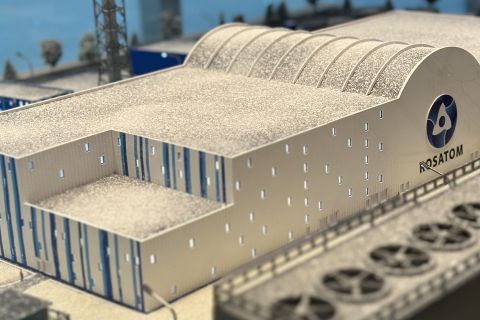
Rosatom obtained a license for the first land-based SMR in Russia
On April 21, Rosenergoatom obtained a license issued by Rostekhnadzor to construct the Yakutsk land-based SMR in the Ust-Yansky District of the Republic of Sakha (Yakutia).

ROSATOM and FEDC agree to cooperate in the construction of Russia's first onshore SNPP
ROSATOM and FEDC have signed a cooperation agreement to build Russia's first onshore SNPP in Yakutia.
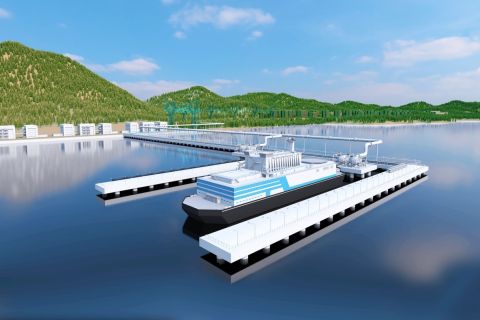
Rosatom develops nuclear fuel for modernized floating power units
Rosatom has completed the development of nuclear fuel for the RITM-200S small modular reactor designed for the upgraded floating power units.

IMAGES
VIDEO
COMMENTS
U.S.Tour in 2023 ... sankai juku 舞踏 Butoh Dance Japan art Ushio Amagatsu 山海塾 ...
SANKAI JUKU Official digest movie "MEGURI" 山海塾 - Butoh Dance 舞踏 -. 舞踏 (BUTOH)カンパニー「山海塾」及び主宰する天児牛大の作品情報、公演情報、映像などを紹介しています。. Introduces the work information, performance information, videos, etc. of Butoh Company "Sankai Juku" and the ...
Sankai Juku. Sankai Juku performing at the Festival Internacional Cervantino. Sankai Juku (山海塾) is an internationally known butoh dance troupe. Co-founded by Amagatsu Ushio in 1975, they are touring worldwide, performing and teaching. As of 2010, Sankai Juku had performed in 43 countries and visited more than 700 cities.
The 2023 North American tour of Sankai Juku is supported by the Agency for Cultural Affairs, Government of Japan through the Japan Arts Council. Sankai Juku is a Butoh dance company founded by ...
Japan's foremost contemporary Butoh dance company, Sankai Juku, is making a rare U.S. tour and stopping at The Joyce Theater through November 5. They will perform KŌSA - between two mirrors ...
Sankai Juku, the all-male Japanese company, which has been touring the world for nearly 50 years with a popularized version of the Japanese style Butoh, returned to the Joyce Theater on Tuesday ...
Sankai Juku, (Tokyo, Japan) North American Tour Produced by: Pomegranate Arts Linda Brumbach, Executive Producer Alisa E. Regas, Associate Producer. World Premiere: Kitakyushu Performing Arts Center, March 2015. Sankai Juku's 2019 North American tour is supported by Shiseido
Sankai Juku to bring 'Umusuna' to UW. Originally published September 27, 2015 at 7:00 am Updated October 2, 2015 at 4:23 pm. Every production of this world-renowned butoh troupe contains ...
Yanagawa Civic Cultural Center Suito Yanagawa. Sep 17. Toyooka / JPN
Sankai Juku is a Butoh company based in France and Japan. The company's works, which are known for their sophisticated physical expression and formative beauty, have been appreciated in forty-eight countries around the world. Sankai Juku's director and choreographer, Ushio Amagatsu, regarded his Butoh as a "dialogue with gravity," and ...
This tour features "KŌSA — Between Two Mirrors," which rearranges excerpts from previous powerful works by founder Ushio Amagatsu. Sankai Juku rarely visits the Bay Area and is giving one performance only. It's worth scrapping your lighter plans to catch it. Sankai Juku: 7:30 p.m. Saturday, Oct. 7. $15-$95.
The Japanese avant-garde dance troupe Sankai Juku has canceled the rest of its 10-city United States tour following the death of one of its dancers during the company's opening performance in ...
In KŌSA - between two mirrors, the world-renowned Butoh dance troupe Sankai Juku explores themes of anxiety and grief in the visceral, captivating cadence they are known best for. Directed, choreographed, and designed by Ushio Amagatsu, the group's founder, this piece is a meditation on the anxieties acutely felt by many in the past few years.
Tokyo's Sankai Juku is known worldwide for its elegance, precision, and emotional depth. Founder Ushio Amagatsu is one of the premiere choreographers in the world today. These rare works are to be experienced more than watched. ... Suave Gonzalez - Never Give Up Tour Jun 6, 2024 Artist, speaker, and the first formerly incarcerated person in ...
Sankai Juku. In KŌSA - between two mirrors, the world-renowned Butoh dance troupe Sankai Juku explores themes of anxiety and grief in the visceral, captivating cadence they are known best for. Directed, choreographed, and designed by Ushio Amagatsu, the group's founder, this piece is a meditation on the anxieties acutely felt by many in the ...
Tokyo-based company Sankai Juku returns for a rare North American tour with KOSA - between two mirrors, a new work featuring some of its most singular moments of sublime visual spectacle, technical precision, and emotional depth.Dance Magazine says: "Amagatsu conveys the infinitely minute yet spellbinding transformations of a world in constant metamorphosis."
Sankai Juku's 2019 North American tour is supported by the Agency for Cultural Affairs, Government of Japan through the Japan Arts Council, and Shiseido Co., Lt 3. ... SANKAI JUKU is a Butoh dance company, founded by Ushio Amagatsu in 1975. It has toured internationally since 1980, and it world premieres a ...
Speciality Museums. Write a review. Be the first to upload a photo. Upload a photo. Suggest edits to improve what we show. Improve this listing. The area. Raskovoi ul., d. 37, Elektrostal 144003 Russia. Reach out directly.
The two-hour private tour was with a former Intourist tour guide named Maria. Maria lived in Moscow all her life and through the communist era of 60s to 90s. She has been a tour guide for more than 30 years. Being in her 60s, she moved rather quickly for her age. We traveled and crammed with Maria and other Muscovites on the metro to visit 10 ...
Elektrostal is a city in Moscow Oblast, Russia, located 58 kilometers east of Moscow. Elektrostal has about 158,000 residents. Mapcarta, the open map.
21 April 2023 Rosatom obtained a license for the first land-based SMR in Russia. On April 21, Rosenergoatom obtained a license issued by Rostekhnadzor to construct the Yakutsk land-based SMR in the Ust-Yansky District of the Republic of Sakha (Yakutia).